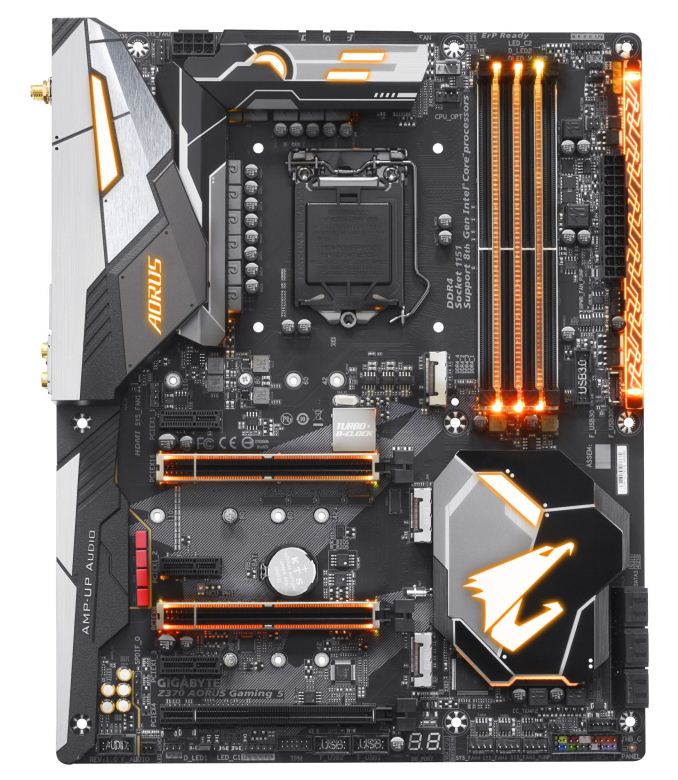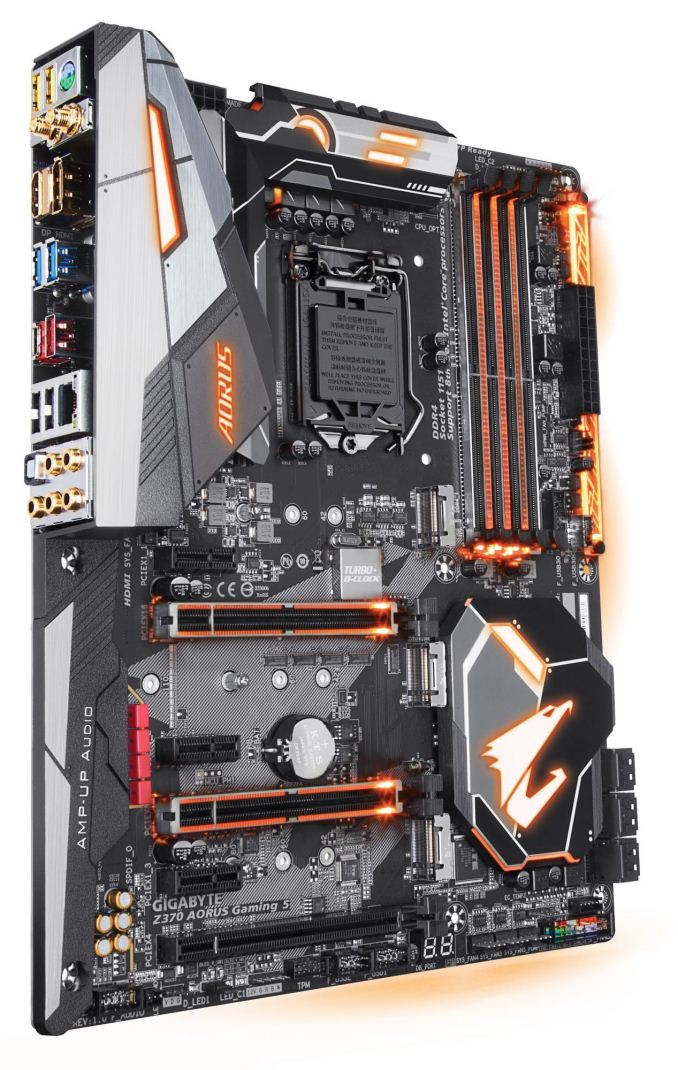Analyzing Z370 for Intel's 8th Generation Coffee Lake: A Quick Look at 50+ Motherboards
by Ian Cutress, Anton Shilov, Joe Shields & Gavin Bonshor on October 20, 2017 2:00 PM ESTGIGABYTE Z370 Gaming 5
The next board from GIGABYTE is the Z370 AORUS Gaming 5. The Gaming 5 sits just below the Gaming 7 in the product stack with a few different features as well as some aesthetic changes. A cursory look at the board and for the most part it looks like the Gaming 7 but with a reduction in some of the features.
The Gaming 5 keeps the black PCB and the AORUS falcon stenciled across the bottom but the stencil appears to be shifted a bit lower on the board, ending at the top PCIe x1 slot. RGB LEDs populate the same locations as on the Ultra Gaming and add more to the I/O shroud and the VRM heatsink. Both the VRM heatsink and shroud have silver colored design elements and a slightly different shape to some of the other GIGABYTE models. The PCH heatsink has an angular aesthetic as well as additional RGB LEDs. The Gaming 5 also has two RGB LED headers (both RGBW headers) all controlled by the RGB Fusion Software.
The board has four reinforced memory slots supporting dual-channel DDR4 with capacity up to 64GB and speeds of DDR4-4133+. For the PCIe slots, there are two full-length reinforced slots at x16 and x8 from the CPU, and the third, non-reinforced full-length x4 slot at the bottom from the chipset. The PCIe x1 slots are also in the same locations as the Gaming 7, one above each of the full-length PCIe slots.
SATA for the Gaming 5 involves six ports supporting RAID 0, 1, 5, and 10. The Gaming 5 places all six together and oriented the same way on the board. The board has three M.2 slots (1x 110mm, 2x 80mm), however, none have a heatsink as the flagship Gaming 7 did. For fan connectivity, there are a total of six on the board; two up top by the CPU, three on the bottom, and another just above the top PCIe x1 slot. The audio codec is the same Realtek ALC1220 as the Gaming 7, but we are unable to tell if it has EMI shielded from the images. There is still a single Intel I219-V NIC, but the Gaming 5 adds integrated WiFi and Bluetooth capabilities. The 5-pin Thunderbolt 3 header moves down to the bottom right-hand corner of the board, just above the front panel headers.
USB 3.1 (10 Gbps) support is handled by the ASMedia 3142 controller and provides a Type-C port and Type-A port on the back panel IO. The chipset provides an additional six USB 3.1 (5 Gbps) ports with four on the back panel and two more available through an internal USB header. There is also USB 2.0 support with two ports on the back panel and four through internal headers. The back panel IO has DisplayPort and HDMI outputs for onboard video, the Wi-Fi adapter, NIC, and gold plated audio with SPDIF.















83 Comments
View All Comments
tommythorn - Monday, October 23, 2017 - link
While that feature page is great, the thunderbolt part is slightly misleading as a few of them supports it via an add-in-card. The page only lists the one that has it built-in. (The lackluster support for TB3 as well as 10 GbE is disappointing).OFelix - Saturday, October 21, 2017 - link
ThanksStochastic - Friday, October 20, 2017 - link
Would you consider putting out some simple Wirecutter-style recommendations? A lot of people (including myself) would like someone else who is better informed to simplify the decision-making process.Ian Cutress - Friday, October 20, 2017 - link
When we get our Z370 reviews underway, we'll start doing some buyers guidesStochastic - Friday, October 20, 2017 - link
Great, thanks!IGTrading - Sunday, October 22, 2017 - link
When do we get a 50+ AMD motherboard article guys ? :)abrowne1993 - Friday, October 20, 2017 - link
Okay but which one looks the coolest?dave_the_nerd - Friday, October 20, 2017 - link
"Whoever thought this was a good idea at Intel needs to be fired."Well... gee... why don't you tell us how you really feel?
DigitalFreak - Friday, October 20, 2017 - link
This whole notch thing makes me wonder if the 8xxx series was originally supposed to work in existing motherboards, but Intel ran into issues at the last minute.KaarlisK - Saturday, October 21, 2017 - link
Honestly, I cannot see the issue. The pins were changed so that nothing bad will happen if you put the wrong CPU in the wrong motherboard.As for the notches, I for one am happy that they were not changed. This means they can reuse the physical design, which lowers validation costs, which makes the CPUs cheaper.